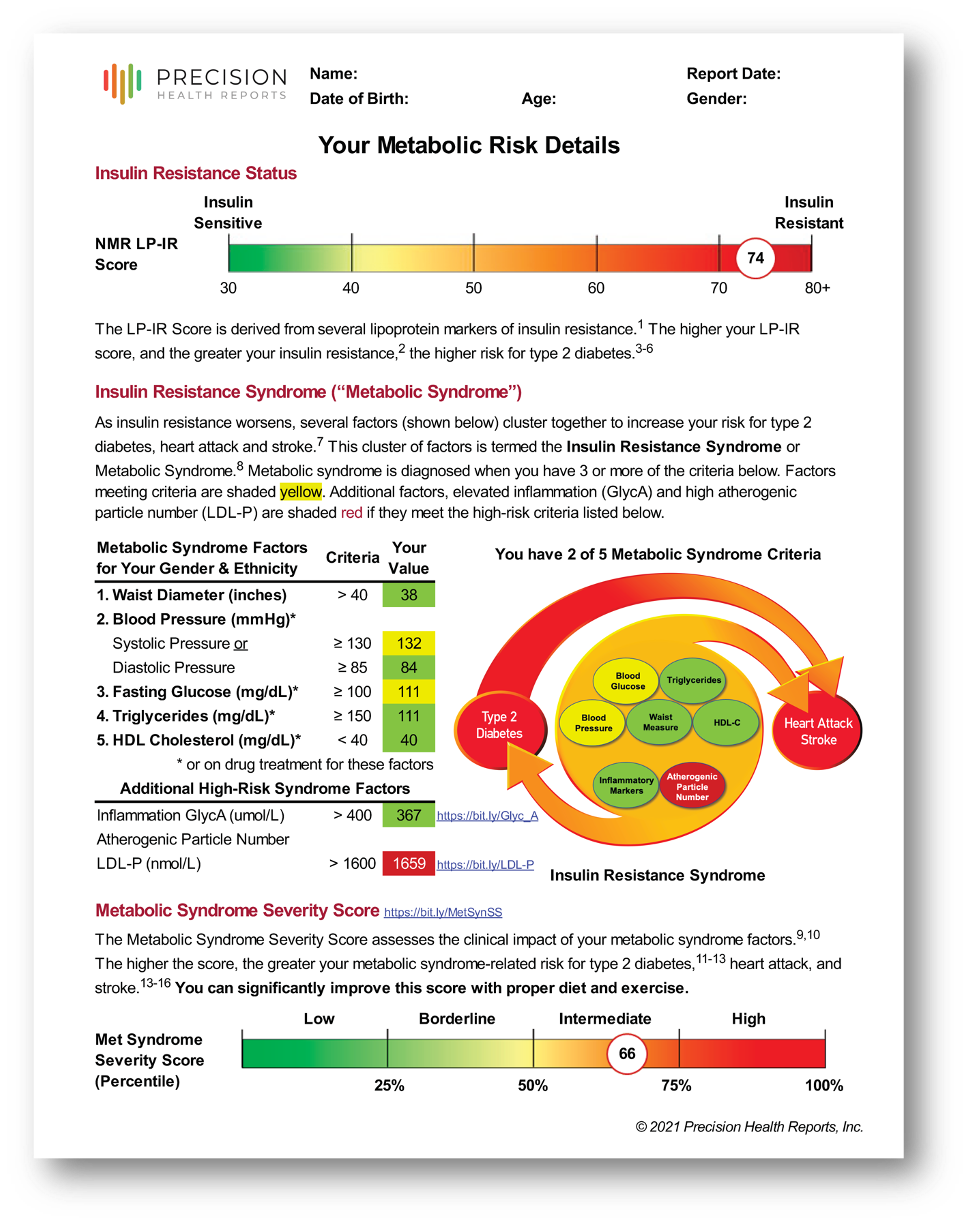What you can learn from YOUR Cardiometabolic Risk Assessment Report
Now that you have completed your Cardiometabolic Risk Assessment, it is important to understand your results and build a plan of action to maintain your health and make course corrections where appropriate.
We strongly recommend that before taking ANY action based on this diagnostic risk assessment, you should read through your report thoroughly and consult with your physician.
What is in Your Complete Cardiometabolic Risk Assessment Report
Part 1: Your Cardiometabolic Risk Summary
Focuses attention on the modifiable metabolic factors that constitute Insulin Resistance Syndrome (“Metabolic Syndrome”)
Provides easy-to-follow graphics that identify the severity of your Metabolic Risk, Diabetic Risk, and Cardiovascular Risk
Serves as a quick reference when talking with your healthcare provider or health coach
Although this summary alone may be enough, we unpack the details in the following sections of the report to provide additional context to the individualized risk values shown here.
Part 2: Your Metabolic Syndrome Risk Details
Identifies your insulin resistance status using the Lipoprotein Insulin Resistance (LP-IR) Score
Outlines your specific metabolic health goals and values that constitute metabolic syndrome
Reports high-risk inflammatory and lipoprotein particle number values that increase insulin resistance related to greater diabetic and cardiovascular risk
Incorporates an outcome-proven Metabolic Syndrome Severity Score that further discriminants individual risk beyond individual metabolic syndrome factors
Part 3: Your Diabetic Risk Details
Graphically presents the values necessary to assess your risk of type 2 diabetes including your current fasting glucose and NMR Lipoprotein Insulin Resistance (LP-IR) Score
Reports your gender-specific 8-Year Risk of Developing Diabetes based on outcome data integrating fasting glucose and LP-IR values
Demonstrates that your personal diabetic risk is modifiable through improvement in your LP-IR Score and fasting glucose values
Remember that your risk is modifiable and reducing your risk starts with reducing your insulin resistance (LP-IR score).
Part 4: Your Cardiovascular Risk Details
Reports your 10-year and Lifetime Cardiovascular Risk Score based on the American College of Cardiology (ACC) guidelines
Identifies the individual risk enhancing factors contributes to your cardiovascular risk
Determines your Overall Cardiovascular Risk by incorporating your calculated risk and presence of risk enhancing factors
Provides your specific lipoprotein management goals using national and international guidelines
This section in specifically tuned to provide a comprehensive understanding of your risk and goals that, when met, will optimize cardiovascular risk reduction.
Part 5: Your Comprehensive Risk Tracking Charts
Clearly demonstrates the impact of clinical and behavioral interventions over time
The design visually reinforces improved behavior toward a healthier risk score
Cumulative tracking pages are a working document to set future goals
Seeing your body’s response over time has a positive association with reaching your goals. Positive feedback drives continued behavior improvements that you can see and feel!
Part 6: Links to Additional Information and Your Survey Answers
Additional information to links for topics including:
A run down of your answers to your pre-assessment survey as a reference to recall how your answers affected your complete Cardiometabolic Risk Assessment
Part 7: LabCorp’s complete Nuclear Magnetic Resonance (NMR) LipoProfile® report and additional relevant biomarker values
Important lipoprotein values: ApoB or LDL particle number (LDL-P)
Traditional cholesterol and triglyceride values (total cholesterol, triglycerides, HDL & LDL cholesterol)
Fasting glucose & Lipoprotein Insulin Resistance (LP-IR) Score
GlycA, an advanced biomarker of systemic inflammation
Although our report wraps significant additional context around the point-in-time biomarkers from LabCorp’s NMR LipoProfile® report and the other advanced biomarkers, we know seeing the raw values is important, too.








